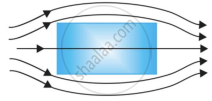Advertisements
Advertisements
प्रश्न
Explain qualitatively on the basis of domain picture the irreversibility in the magnetisation curve of a ferromagnet.
उत्तर
The hysteresis curve (B-H curve) of a ferromagnetic material is shown in the following figure.

It can be observed from the given curve that magnetisation persists even when the external field is removed. This reflects the irreversibility of a ferromagnet.
APPEARS IN
संबंधित प्रश्न
The magnetic susceptibility of platinum is 0.0001. It's relative permeability is:
Answer the following question.
Write three points of differences between para-, dia- and ferromagnetic materials, giving one example for each.
Identify the following magnetic materials :
A rod of magnetic material of cross-section 0.25 cm2 is placed in a magnetizing field of intensity 4000 A/m-1. The magnetic flux passing through the rod is 25 × 10-6 Wb. Find out
(a) relative permeability
(b) magnetic susceptibility and
(c) magnetisation of the rod.
The magnetic susceptibility of a paramagnetic material at - 73 °C is 0.0075. Its value at -173 °C will be ______.
Magnetization of the sample is ______.
A domain in a ferromagnetic substance is in the form of a cube of side length 1 µm. If it contains 6 x 1010 atoms and each atomic dipole has a dipole moment of 7 x 10-24 Am2, then magnetization of the domain is ____________.
A long solenoid has 1000 turns per metre and carries a current of 1 A. It has a soft iron core of µr = 1000. The core is heated beyond the Curie temperature, Tc.
- The H field in the solenoid is (nearly) unchanged but the B field decreases drastically.
- The H and B fields in the solenoid are nearly unchanged.
- The magnetisation in the core reverses direction.
- The magnetisation in the core diminishes by a factor of about 108.
A uniform magnetic field gets modified as shown in figure when two specimens A and B are placed in it.
 |
 |
| (a) | (b) |
- Identify the specimen A and B.
- How is the magnetic susceptibility of specimen A different from that of specimen B?
